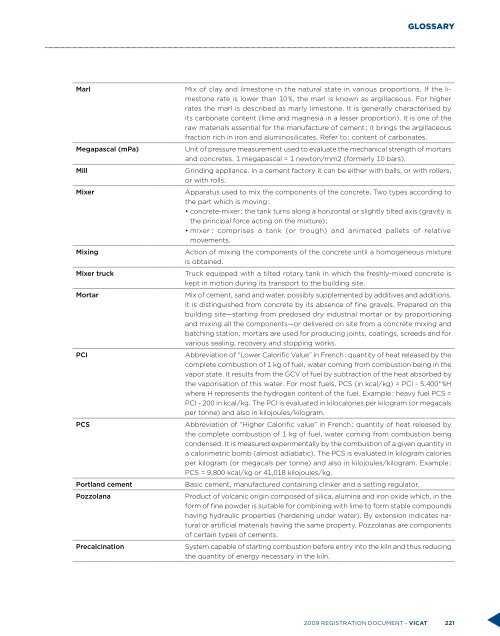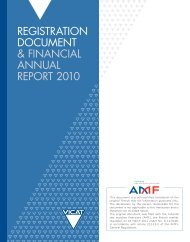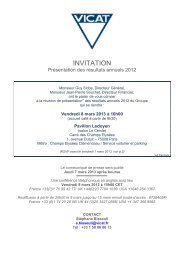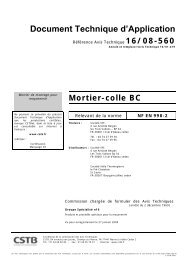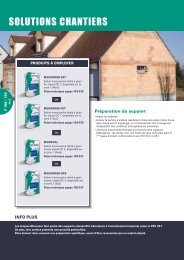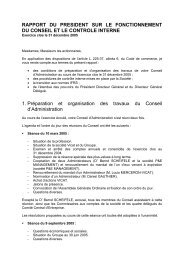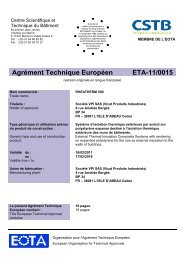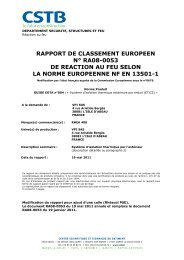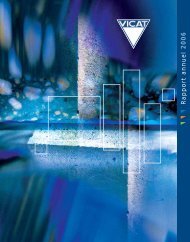6 - Vicat
6 - Vicat
6 - Vicat
- No tags were found...
Create successful ePaper yourself
Turn your PDF publications into a flip-book with our unique Google optimized e-Paper software.
GLOSSARYMarlMegapascal (mPa)MillMixerMixingMixer truckMortarPCIPCSPortland cementPozzolanaPrecalcinationMix of clay and limestone in the natural state in various proportions. If the limestonerate is lower than 10 %, the marl is known as argillaceous. For higherrates the marl is described as marly limestone. It is generally characterised byits carbonate content (lime and magnesia in a lesser proportion). It is one of theraw materials essential for the manufacture of cement ; it brings the argillaceousfraction rich in iron and aluminosilicates. Refer to : content of carbonates.Unit of pressure measurement used to evaluate the mechanical strength of mortarsand concretes. 1 megapascal = 1 newton/mm2 (formerly 10 bars).Grinding appliance. In a cement factory it can be either with balls, or with rollers,or with rolls.Apparatus used to mix the components of the concrete. Two types according tothe part which is moving :• concrete-mixer : the tank turns along a horizontal or slightly tilted axis (gravity isthe principal force acting on the mixture) ;• mixer : comprises a tank (or trough) and animated pallets of relativemovements.Action of mixing the components of the concrete until a homogeneous mixtureis obtained.Truck equipped with a tilted rotary tank in which the freshly-mixed concrete iskept in motion during its transport to the building site.Mix of cement, sand and water, possibly supplemented by additives and additions.It is distinguished from concrete by its absence of fine gravels. Prepared on thebuilding site—starting from predosed dry industrial mortar or by proportioningand mixing all the components—or delivered on site from a concrete mixing andbatching station, mortars are used for producing joints, coatings, screeds and forvarious sealing, recovery and stopping works.Abbreviation of “Lower Calorific Value” in French : quantity of heat released by thecomplete combustion of 1 kg of fuel, water coming from combustion being in thevapor state. It results from the GCV of fuel by subtraction of the heat absorbed bythe vaporisation of this water. For most fuels, PCS (in kcal/kg) = PCI - 5,400* %Hwhere H represents the hydrogen content of the fuel. Example : heavy fuel PCS =PCI - 200 in kcal/kg. The PCI is evaluated in kilocalories per kilogram (or megacalsper tonne) and also in kilojoules/kilogram.Abbreviation of “Higher Calorific value” in French : quantity of heat released bythe complete combustion of 1 kg of fuel, water coming from combustion beingcondensed. It is measured experimentally by the combustion of a given quantity ina calorimetric bomb (almost adiabatic). The PCS is evaluated in kilogram caloriesper kilogram (or megacals per tonne) and also in kilojoules/kilogram. Example :PCS = 9,800 kcal/kg or 41,018 kilojoules/kg.Basic cement, manufactured containing clinker and a setting regulator.Product of volcanic origin composed of silica, alumina and iron oxide which, in theform of fine powder is suitable for combining with lime to form stable compoundshaving hydraulic properties (hardening under water). By extension indicates naturalor artificial materials having the same property. Pozzolanas are componentsof certain types of cements.System capable of starting combustion before entry into the kiln and thus reducingthe quantity of energy necessary in the kiln.2009 registration document - VICAT 221


